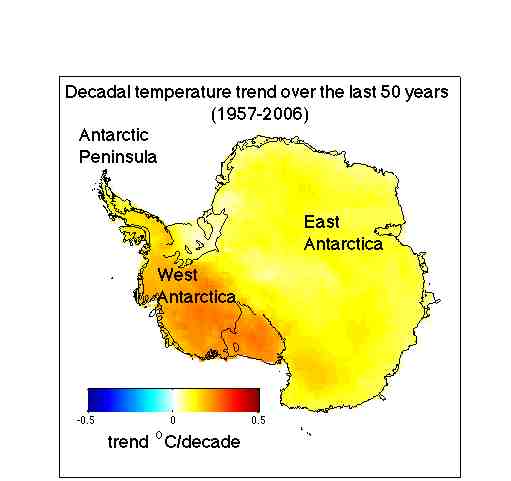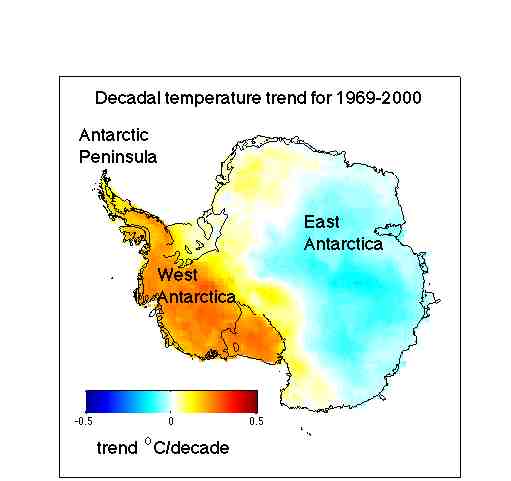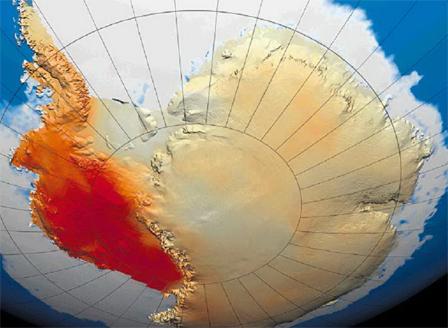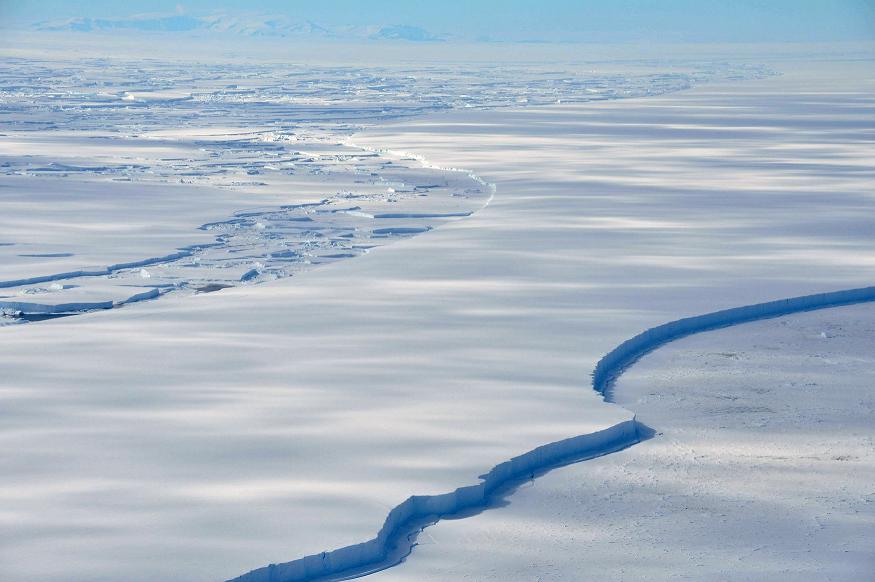Weblog auteur Eric Steig van de universiteit van Washington
A couple of us
(Eric and Mike) are co-authors on a paper coming out in Nature this
week (Jan. 22, 09). We have already seen misleading interpretations of
our results in the popular press and the blogosphere, and so we
thought we would nip such speculation in the bud.
 The
paper shows that Antarctica has been warming for the last 50 years,
and that it has been warming especially in West Antarctica (see the
figure). The results are based on a statistical blending of satellite
data and temperature data from weather stations. The results don't
depend on the statistics alone. They are backed up by independent data
from automatic weather stations, as shown in our paper as well as in
updated work by Bromwich, Monaghan and others (see their AGU abstract,
here), whose earlier work in JGR was taken as contradicting ours.
There is also a paper in press in Climate Dynamics (Goosse et al.)
that uses a GCM with data assimilation (and without the satellite data
we use) and gets the same result. Furthermore, speculation that our
results somehow simply reflect changes in the near-surface inversion
is ruled out by completely independent results showing that
significant warming in West Antarctica extends well into the
troposphere. And finally, our results have already been validated by
borehole thermometery — a completely independent method — at at least
one site in West Antarctica (Barrett et al. report the same rate of
warming as we do, but going back to 1930 rather than 1957; see the
paper in press in GRL). The
paper shows that Antarctica has been warming for the last 50 years,
and that it has been warming especially in West Antarctica (see the
figure). The results are based on a statistical blending of satellite
data and temperature data from weather stations. The results don't
depend on the statistics alone. They are backed up by independent data
from automatic weather stations, as shown in our paper as well as in
updated work by Bromwich, Monaghan and others (see their AGU abstract,
here), whose earlier work in JGR was taken as contradicting ours.
There is also a paper in press in Climate Dynamics (Goosse et al.)
that uses a GCM with data assimilation (and without the satellite data
we use) and gets the same result. Furthermore, speculation that our
results somehow simply reflect changes in the near-surface inversion
is ruled out by completely independent results showing that
significant warming in West Antarctica extends well into the
troposphere. And finally, our results have already been validated by
borehole thermometery — a completely independent method — at at least
one site in West Antarctica (Barrett et al. report the same rate of
warming as we do, but going back to 1930 rather than 1957; see the
paper in press in GRL).
Here are some important things the paper does NOT show:
 1)
Our results do not contradict earlier studies suggesting that some
regions of Antarctica have cooled. Why? Because those studies were
based on shorter records (20-30 years, not 50 years) and because the
cooling is limited to the East Antarctic. Our results show this too,
as is readily apparent by comparing our results for the full 50 years
(1957-2006) with those for 1969-2000 (the dates used in various
previous studies), below. 1)
Our results do not contradict earlier studies suggesting that some
regions of Antarctica have cooled. Why? Because those studies were
based on shorter records (20-30 years, not 50 years) and because the
cooling is limited to the East Antarctic. Our results show this too,
as is readily apparent by comparing our results for the full 50 years
(1957-2006) with those for 1969-2000 (the dates used in various
previous studies), below.
2) Our results do not necessarily contradict the generally-accepted
interpretation of recent East Antarctic cooling put forth by David
Thompson (Colorado State) and Susan Solomon (NOAA Aeronomy Lab). In an
important paper in Science, they presented evidence that this cooling
trend is linked to an increasing trend in the strength of the
circumpolar westerlies, and that this can be traced to changes in the
stratosphere, mostly due to photochemical ozone losses. Substantial
ozone losses did not occur until the late 1970s, and it is only after
this period that significant cooling begins in East Antarctica.
3) Our paper — by itself — does not address whether Antarctica's
recent warming is part of a longer term trend. There is separate
evidence from ice cores that Antarctica has been warming for most of
the 20th century, but this is complicated by the strong influence of
El Niño events in West Antarctica. In our own published work to date
(Schneider and Steig, PNAS), we find that the 1940s [edit for clarity:
the 1935-1945 decade] were the warmest decade of the 20th century in
West Antarctica, due to an exceptionally large warming of the tropical
Pacific at that time.
So what do our results show? Essentially, that the big picture of
Antarctic climate change in the latter part of the 20th century has
been largely overlooked. It is well known that it has been warming on
the Antarctic Peninsula, probably for the last 100 years (measurements
begin at the sub-Antarctic Island of Orcadas in 1901 and show a nearly
monotonic warming trend). And yes, East Antarctica cooled over the
1980s and 1990s (though not, in our results, at a statistically
significant rate). But West Antarctica, which no one really has paid
much attention to (as far as temperature changes are concerned), has
been warming rapidly for at least the last 50 years.
Why West Antarctica is warming is just beginning to be explored, but
in our paper we argue that it basically has to do enhanced meridional
flow — there is more warm air reaching West Antarctica from farther
north (that is, from warmer, lower latitudes). In the parlance of
statistical climatology, the "zonal wave 3 pattern" has increased (see
Raphael, GRL 2004). Something that goes along with this change in
atmospheric circulation is reduced sea ice in the region (while sea
ice in Antarctica has been increasing on average, there have been
significant declines off the West Antarctic coast for the last 25
years, and probably longer). And in fact this is self reinforcing (less
sea ice, warmer water, rising air, lower pressure, enhanced storminess).
The obvious question, of course, is whether those changes in
circulation are themselves simply "natural variability" or whether
they are forced — that is, resulting from changes in greenhouse gases.
There will no doubt be a flurry of papers that follow ours, to address
that very question. A recent paper in Nature Geosciences by Gillet et
al. examined trends in temperatures in the both Antarctic and the
Arctic, and concluded that "temperature changes in both … regions can
be attributed to human activity." Unfortunately our results weren't
available in time to be made use of in that paper. But we suspect it
will be straightforward to do an update of that work that does
incorporate our results, and we look forward to seeing that happen. |



 The
paper shows that Antarctica has been warming for the last 50 years,
and that it has been warming especially in West Antarctica (see the
figure). The results are based on a statistical blending of satellite
data and temperature data from weather stations. The results don't
depend on the statistics alone. They are backed up by independent data
from automatic weather stations, as shown in our paper as well as in
updated work by Bromwich, Monaghan and others (see their AGU abstract,
here), whose earlier work in JGR was taken as contradicting ours.
There is also a paper in press in Climate Dynamics (Goosse et al.)
that uses a GCM with data assimilation (and without the satellite data
we use) and gets the same result. Furthermore, speculation that our
results somehow simply reflect changes in the near-surface inversion
is ruled out by completely independent results showing that
significant warming in West Antarctica extends well into the
troposphere. And finally, our results have already been validated by
borehole thermometery — a completely independent method — at at least
one site in West Antarctica (Barrett et al. report the same rate of
warming as we do, but going back to 1930 rather than 1957; see the
paper in press in GRL).
The
paper shows that Antarctica has been warming for the last 50 years,
and that it has been warming especially in West Antarctica (see the
figure). The results are based on a statistical blending of satellite
data and temperature data from weather stations. The results don't
depend on the statistics alone. They are backed up by independent data
from automatic weather stations, as shown in our paper as well as in
updated work by Bromwich, Monaghan and others (see their AGU abstract,
here), whose earlier work in JGR was taken as contradicting ours.
There is also a paper in press in Climate Dynamics (Goosse et al.)
that uses a GCM with data assimilation (and without the satellite data
we use) and gets the same result. Furthermore, speculation that our
results somehow simply reflect changes in the near-surface inversion
is ruled out by completely independent results showing that
significant warming in West Antarctica extends well into the
troposphere. And finally, our results have already been validated by
borehole thermometery — a completely independent method — at at least
one site in West Antarctica (Barrett et al. report the same rate of
warming as we do, but going back to 1930 rather than 1957; see the
paper in press in GRL). 1)
Our results do not contradict earlier studies suggesting that some
regions of Antarctica have cooled. Why? Because those studies were
based on shorter records (20-30 years, not 50 years) and because the
cooling is limited to the East Antarctic. Our results show this too,
as is readily apparent by comparing our results for the full 50 years
(1957-2006) with those for 1969-2000 (the dates used in various
previous studies), below.
1)
Our results do not contradict earlier studies suggesting that some
regions of Antarctica have cooled. Why? Because those studies were
based on shorter records (20-30 years, not 50 years) and because the
cooling is limited to the East Antarctic. Our results show this too,
as is readily apparent by comparing our results for the full 50 years
(1957-2006) with those for 1969-2000 (the dates used in various
previous studies), below.